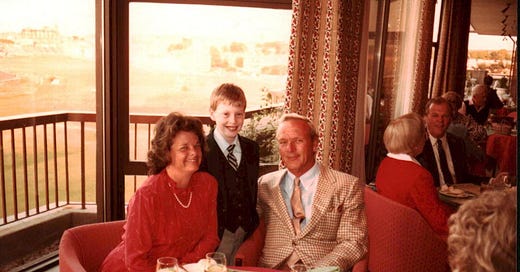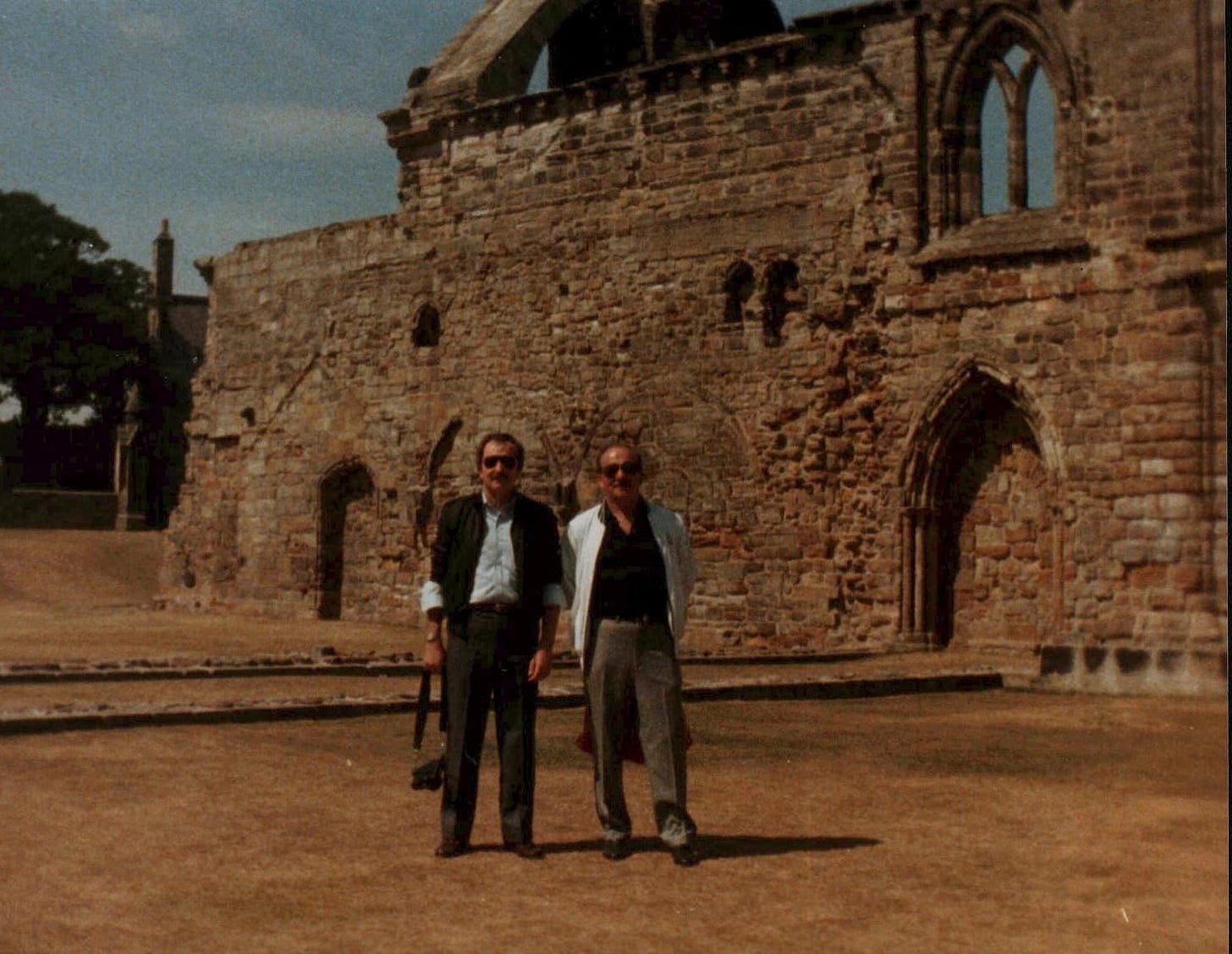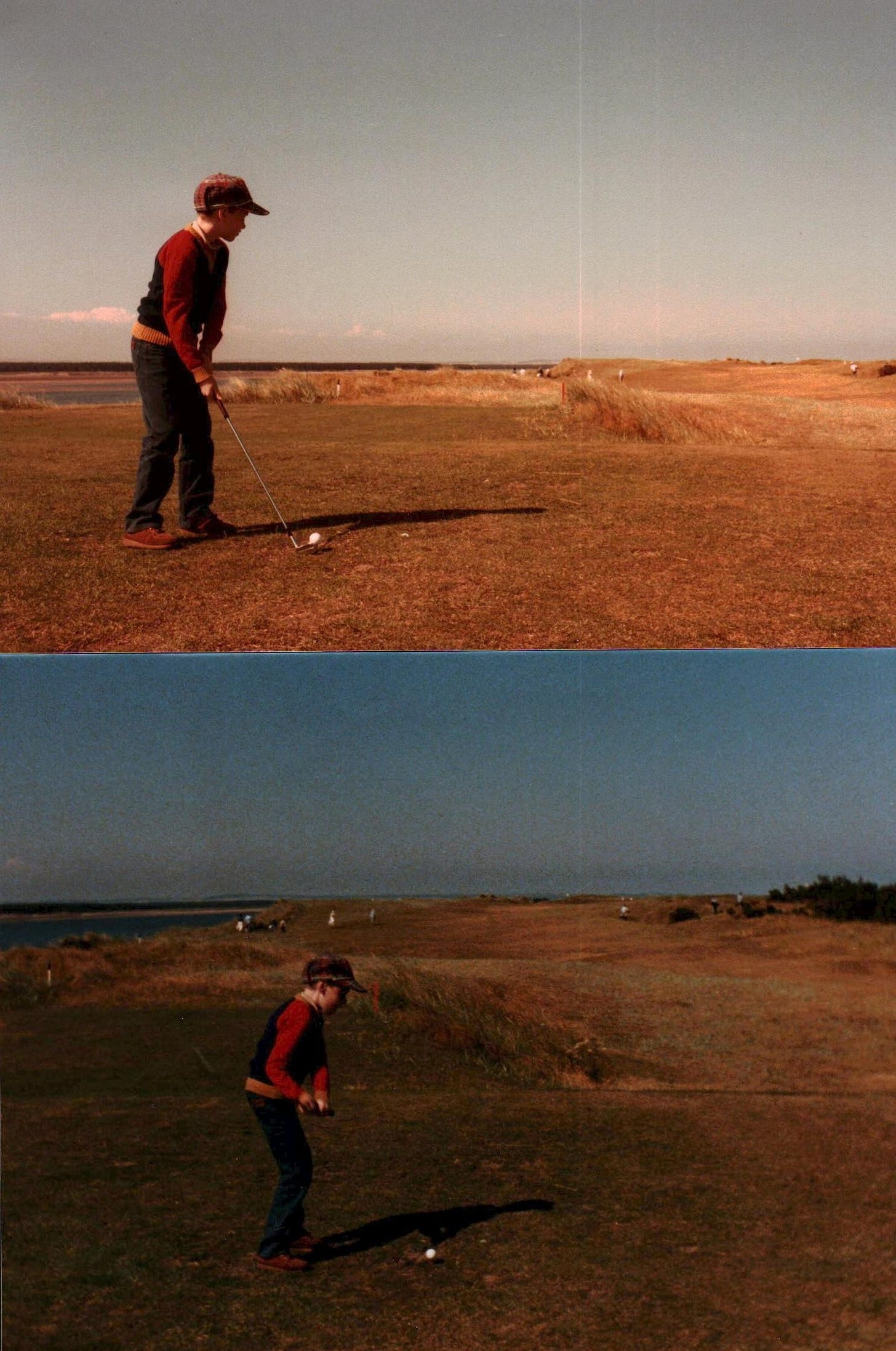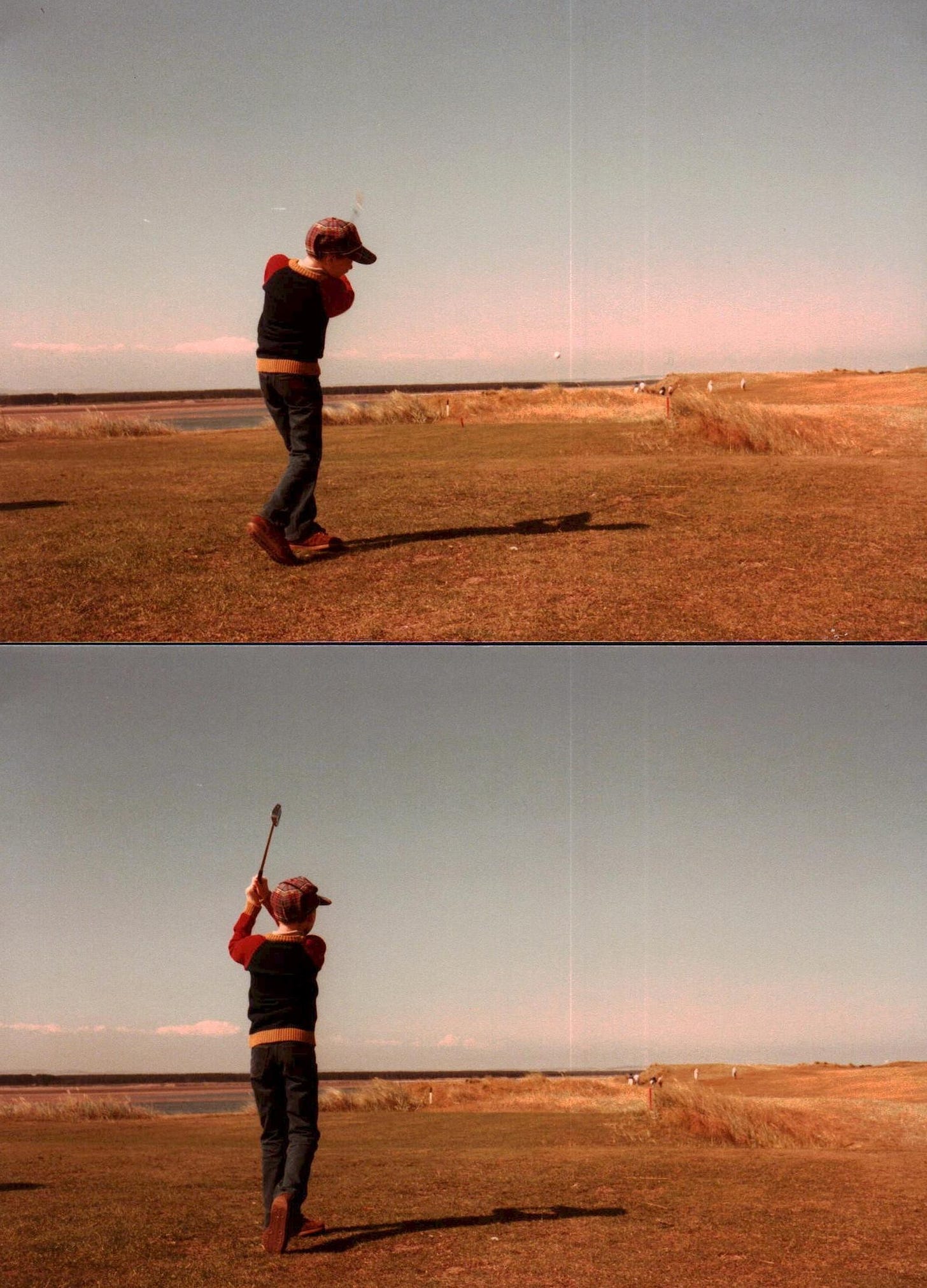Listening to 1984: An Experiment in Time Travel - Part 7 of 12
40 years ago this month, I found myself hanging out with Arnold Palmer and his wife--in Scotland. I spilled my lemonade into his iced tea and the rest is history. (Okay, I made that part up).
July 18-24, 1984 / December 9, 2020
What can I tell you about the golfer whose storied achievements on the fairway and green come second only to the delicious beverage that bears his name? I can tell you he was a warm, affable man with a broad smile, twinkling eyes, and an impressive tan. His social mannerisms and growly voice signaled membership in my grandfather’s generation; his physical presence and glow suggested perpetual youth. He called me “Power Boy.” And his wife Winnie, a sweet, dark-haired lady with a million-watt smile, took me under her wing.
How did this all come to be? How was it that I found myself spending time with the Palmers in, of all places, St. Andrews, Scotland in July of 1984?
To tell this story, I must first tell something of my grandfather, Bob “Top” Lurie. The thumbnail sketch includes combat experience in three wars; various aerial feats as a military, and later civilian, pilot; subsequent reconnaissance missions into the worlds of celebrity and privilege (Unlike Jay Gatsby, Grandpa was not out to impress Daisy Buchanan; he undertook these sorts of stealth ops solely for kicks); and long sojourns in the Middle East that may or may not have involved government intelligence work. One of his key personality traits—which I inherited—was a compulsion to know his heroes personally, which brought us to the Old Course Hotel in July of 1984.
According to family lore, he insinuated to the hotel’s management—without ever saying outright—that he was an upper executive at AT&T and would settle for nothing less than top-tier treatment. He had formulated this plan four or five years back and had reserved a suite for himself, my father, and me for the week of the 1984 British Open before it was on anyone else’s radar. Then he waited.
The resulting trip—perhaps the greatest of all of his coups—was less a brushing of shoulders with golfing legends than an outright collision with them. The irony is that I had only a passing interest in the sport. What cements this trip in my mind is the beautiful moment of harmony it provided between my grandfather and father, and that three generations of Lurie boys got to share this adventure together.
And in that context, plenty of memories loom that had nothing to do with the tournament. There was, for instance, the outbound flight on one of those massive double-decker 747s ubiquitous in late-’70s, early-’80s disaster movies. This plane boasted luxuries I had never heard of, such as a music system built into the armrest (I was probably talking about this for the rest of the year and beyond) and an inflight movie: Lassiter, a WWII-era caper starring Tom Sellick which was—I realize now—wildly inappropriate for a ten-year-old boy. Early in the film, I was treated to a sex scene between the German femme fatale (Lauren Hutton) and some nameless lacky. As he suckled her breasts like a ravenous infant, she reached behind his head and stabbed him in the neck, climaxing as he exhaled his last breath. A lot to unpack there! For my dad, this was just another instance of think-on-your-feet parenting in the wild-and-woolly-1980s, as he quickly clasped a hand over my eyes. (It was not until my work on the current project that I finally experienced this scene in its full strangeness).
I also recall the armrest radio playing Booker T’s “Green Onions” over and over (a bit of timey-wimey portentousness, as I would one day play in a group called the Green Onion Band). Dad has told me that I had a long conversation with a man who worked at the BBC. I vaguely remember this, but the story is that I impressed with my precociousness and knowledge of British culture—gleaned almost entirely from Target Doctor Who novelizations.
Also vivid in my mind: the sight of my grandfather in the airport: straw hat perched on his head, open-necked shirt. Smiling, vibrant, alive. Excited as I’d never seen him, not that he didn’t always have a twinkle in his eye. And, for the first and only time, sporting a moustache. My dad, also relaxed and happy, also mustachioed, fully into his Tom Selleck phase.
The July weather in Scotland was uncharacteristically balmy, as if the notoriously waterlogged northern UK country were in Key West cosplay.
The big revelation on the way to the hotel: Here they drive on the left side of the street! Who made that call and why? It fell to my dad to grapple with this challenge (as well as with the steering wheel being on the “wrong” side in the rental), but he got us to our hotel safely.
I can remember the hotel better than the golf event. The dining area—impressive during the day, decked out at night in soft, shimmering lights as golf pros, celebrities, and British aristocracy mingled. It was all of them—and us. I marveled at the food—chicken, beef, and seafood dishes, nothing unusual but all prepared exceptionally well—unaware that the United Kingdom had a reputation for lackluster cuisine. But what really captured my heart was afternoon tea—the concept and the offerings: scones (somehow light and dense, unlike any I would later taste in the U.S.) slathered in clotted cream; delicate watercress sandwiches; and the tea—prepared perfectly with a strainer, just the right amount of sugar and cream added. I will probably never experience its like again. (UK readers will chortle at all this. But to a midwestern boy in the less-interconnected 1980s, afternoon tea was the height of exoticism). What a civilized custom: to take a break at 4 PM, reconnect with friends, family, colleagues, over lovingly prepared food and tea. A reminder to not get overly caught up in the frantic pace of life. Eastern religions stress that the phenomenological world—what we perceive as material reality—is maya, illusion. I would amend that slightly: The material world is solid enough; but the hamster wheel so many of us frantically run on—some of us out of necessity, many of us because—why, we can’t imagine its absence?… that is the very essence of maya. And this Scottish trip, for the three of us, was the 4 PM teatime in our lives.
Other images flicker across the memory screen, dredged up by these time-travel experiments: my fixation on the hotel and the various gadgets. There was an in-room wet bar (I had never seen one of these before). And, wonder of wonders, each of the two rooms in our suite had a TV. Dad and Grandpa were spellbound by the soothing tones of the BBC announcer narrating the tournament—so different from excitable American broadcasters. But, as a sort of yang to the yin, we also stumbled upon a violent, sex-and-profanity-laden BBC production on the Kennedys. (If news and commentary had a distinctly lowered volume, it seemed that British dramatic television could go in the other direction, especially if the subject was America). Late at night, an actual American production came through: Fort Apache, The Bronx starring Paul Newman. Our collective mood turned wistful as we each quietly checked in with these blunt-force signals from our homeland.
We met other golfers during the week: Peter Jacobsen, Fuzzy Zoeller. I had my picture taken with Jacobsen, but that was more in the line of a fan meet-and-greet. The primary connection was with the Palmers. Grandpa already knew Arnold; with more than a little chutzpah he had parlayed their shared interest in flying into chummy familiarity—an assumption of intimacy that Palmer seemed to roll with.
At the Open, I stood at the front of the crowd with Winnie Palmer watching her husband play—let’s say it was the 12th hole. Mid-play, with all spectators’ eyes on him, he walked up to me and greeted “Power Boy.” I was a mascot for five minutes. Always, the sun descending: In my memory, nearly everything happened in late afternoon, beginning with teatime. Except for the day when the three Luries went golfing on a different course, characterized by winding, Middle-Earth-like hills—you’d expect to see a Hobbit Hole in the side of one. I recall an innocuous conversation about artificial sweetener: Dad was drinking a soda that had some kind of faux sugar that was banned in the US. I don’t remember the substance of the conversation, just the continuation of the easy goodwill that had suffused the entire trip. Actual halcyon light streamed through holes in the pillowy clouds.
Filling in the gaps with archival footage, I learn (or remember) that Seve Ballesteros seized the lead at the Open and won, in about as dramatic a fashion as you’re likely to see in the slow-moving sport of golf. Other key favorites of the announcers were Tom Watson and Bernard Langer. As a backdrop, we see the ever-present Old Course, running right up against the spectacular water hazard that is the ocean.
Something else strikes me as I watch footage of the Open: the favored men’s hairstyle in 1984 seemed to be a sort of “hair helmet”: thick, shaggy on the sides; it stood up and danced in the wind, and probably provided ample heat retention in the fall. I realize with some chagrin that I didn’t truly lose this style until a handful of years ago—yet another way in which I remained stuck in the ‘80s. Seve probably fared best with it: he had a closer, more deliberate cut and his hair rested more naturally on his skull, not rising up like a souffle, as some of the other golfers’ hairstyles did. I don’t see anyone in this footage walking around with Reagan’s slicked-back, 1940s style; I guess we wouldn’t see anything like that until the ascendancy of Alec Baldwin in a few years.
Of our trip, I know what stuck in my grandfather’s mind, because he talked about it continuously over the ensuing years: an event that occurred when the three of us played the “New Course” (which dates to 1895: “new” in that neck of the world) at twilight. There was hardly anyone else out, and, as the sun sank beneath the horizon, I hit an impressive shot as my grandpa captured the whole thing on his camera. There, for all time, Power Boy knocking one into the distance, signaling a glorious future.
Who could have known that this would be my peak as a golfer? That I would lose interest—that, in fact, I had never been especially interested?
And so another memory surfaces from a couple years later: My dad entering my bedroom, picking up a golf magazine, smiling wistfully, and saying—not unkindly—“How do we break it to your grandpa that you’re just not into golf?”
Golf. Castles. Tea. Scones. BBC announcers. More golf. These were the greatest two weeks of my life, only to be equaled in significance by the births of my children. I would not trade a second of this trip for anything—except, perhaps, to get my grandfather back for just one more day. I would trade a lot for that.
***
(2024 Editor’s Note: Watching the footage now, looking at these pictures, I am finally beginning to understand the beating heart of this game. Perhaps I was simply introduced to golf at the wrong time in my life. Most ten-year-olds want to move, move, move. The last thing they want to do is spend several hours walking around grassy fields with grown-ups. But now, 40 years later, this [allegedly] grown-up boy would sure like to spend hours and hours traversing the Old Course [or any course] with his dad and grandfather. Taking a break from “life” to find the essence of life. No fuss. No big thing. Just being.)
Next up: The Rest of July.








Love this
What a great story. Loved reading about your grandfather, and first impressions of international travel. 'Lassiter' brought a flashback, too.